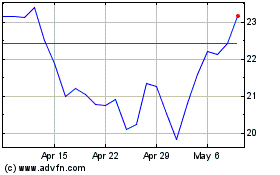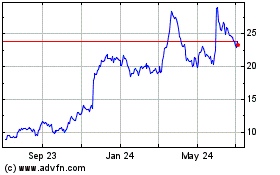By Suzanne Kapner
A dispute over creative control led Ralph Lauren Corp. Chief
Executive Stefan Larsson to leave the struggling luxury fashion
brand after less than two years at the helm.
Mr. Larsson, a 42-year-old fast-fashion executive tapped to work
alongside founder Ralph Lauren, said Thursday that the two men
agreed the business needed to evolve but disagreed over the
company's creative and customer-facing strategies.
"The board, Ralph and I have over the last month worked very
hard to find common ground," Mr. Larsson said on a conference call
with investors, calling his abrupt exit a mutual decision.
"However, we have found that we have different views on how to
evolve."
Shares fell 12% in New York Thursday, and are now down more than
30% over the past year. Ralph Lauren also reported another slide in
quarterly sales.
Executives said turnaround efforts led by Mr. Larsson -- which
included closing stores, pulling back on discounts and jettisoning
some of the company's smaller labels -- were on track, and promised
smaller revenue declines next fiscal year.
Mr. Lauren, 77, who is the company's biggest shareholder,
executive chairman and chief creative officer, didn't participate
in the call. In a news release, the founder said he was committed
to the business plan laid out by Mr. Larsson and would continue "to
move our business and iconic brand forward as we have done for the
last 50 years."
Until a few weeks ago, all had been going well, according to a
person familiar with the situation. Mr. Larsson had made strides
streamlining the supply chain, with the help of new executives he
had brought on board, and Mr. Lauren was supportive of the progress
he was making.
Then, Mr. Larsson told Mr. Lauren that in order for him to be
accountable for executing the business plan outlined in June,
called "The Way Forward," he would need control of the creative
side of the business, which was Mr. Lauren's domain, this person
continued.
In particular, Mr. Larsson argued that he needed the ability to
hire and fire creative talent, this person said. Mr. Lauren, who
has overseen the creative side of the business since he founded his
label in 1967, was unwilling to cede that control.
Tensions continued to bubble over the next few weeks, with the
two men disagreeing over how the design, marketing and creative
vision should evolve, another person said. The board met to discuss
the impasse in recent days, and directors backed Mr. Lauren, this
person continued.
Mr. Larsson will leave Ralph Lauren on May 1 and the company has
started a CEO search. Its finance chief, Jane Nielsen, will lead
the turnaround effort in the interim, the company said.
"Ralph is not interested in running the business day-to-day,"
Ms. Nielsen said.
Mr. Lauren is one of the few remaining designers of his
generation to retain an active role in his company, which unlike
rivals hasn't sold out to a large corporation.
The designer retained the CEO title until passing it to Mr.
Larsson in November 2015, two years after his longtime No. 2
executive, Roger Farah, stepped back from his daily role as
president and chief operating officer. Mr. Farah later left the
company and is now the CEO of Tory Burch LLC.
Although many designers, including Calvin Klein, Donna Karan and
Yves Saint Laurent, found success by pairing their creative talents
with a strong business leader, clashes between the two sides aren't
uncommon in the fashion industry. Diane Von Furstenberg's CEO left
her company late last year, after just 18 months on the job.
People who know Mr. Lauren said he is truly interested in seeing
his company evolve. "There is not a more modern thinker or someone
more open to change than he is," said Robert Burke, who spent 11
years at the company before leaving to join Bergdorf Goodman in
1999. "But it's a question of how much change a company and its
consumers can handle."
Citi analyst Kate McShane said finding a successor to Mr.
Larsson "could be challenging as the new CEO's vision still has to
fit with that of Mr. Lauren's." In a note to clients, she said Mr.
Larsson was considered "one of the best players in the industry"
and worried that executives he recruited to the company would
follow him out the door.
Ralph Lauren's profits were sagging when Mr. Larsson took the
helm in November 2015. His strategy has been to focus on fewer
brands and speed the company's supply chain. He has also started to
slash costs, cutting more than 1,000 jobs, or 8% of the full-time
staff, and is closing dozens of stores. In an interview in June, he
also touched on product changes, saying he wanted the merchandise
to focus on core items like blazers, military jackets and polo
shirts, but with an updated look.
Mr. Larsson joined the company from Gap Inc.'s Old Navy, where
he was credited with helping revive sales at the casual apparel
brand. Previously, he spent 15 years at fast-fashion retailer
Hennes & Mauritz AB.
He stands to receive more than $26 million in exit pay,
depending on the performance of the company and its shares over the
next few years, according to his severance agreement. The company
promised to pay him at least $10 million in cash, as well as a
bonus for the fiscal year ending in March that has a target of
$3.75 million, the filing shows.
For the fiscal third quarter, Ralph Lauren reported profit of
$82 million, down from $131 million, a year earlier. Revenue fell
12% to $1.71 billion.
Executives said Thursday they expected sales to decline by a
midteens percentage for the fiscal year and to shrink by a
mid-single-digit percentage next fiscal year.
--Imani Moise and Theo Francis contributed to this article.
Write to Suzanne Kapner at Suzanne.Kapner@wsj.com
(END) Dow Jones Newswires
February 02, 2017 16:58 ET (21:58 GMT)
Copyright (c) 2017 Dow Jones & Company, Inc.
Gap (NYSE:GPS)
Historical Stock Chart
From Mar 2024 to Apr 2024

Gap (NYSE:GPS)
Historical Stock Chart
From Apr 2023 to Apr 2024
